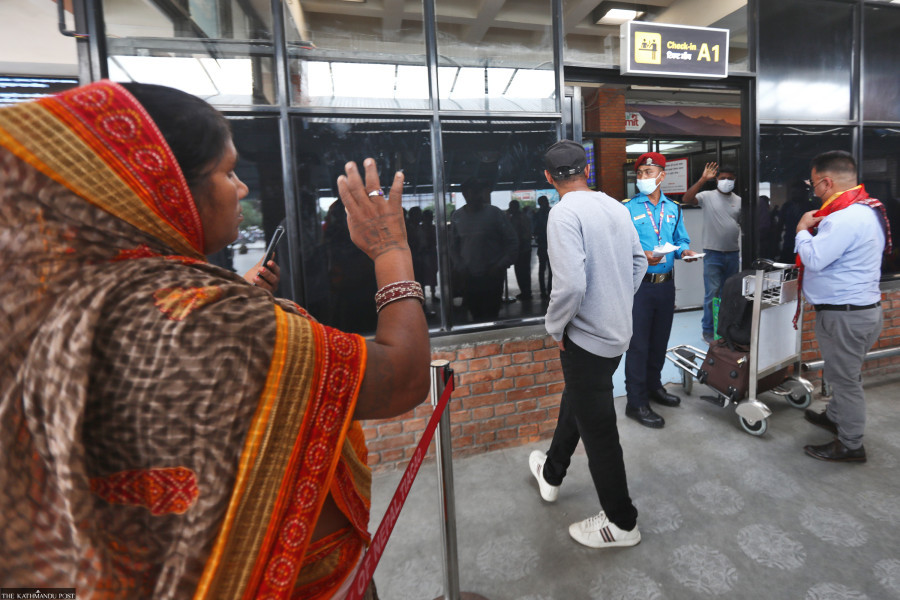Columns
Labour migration, gender and caste
Working abroad is not all bad for the marginalised as it brings much more than financial gains.
Mitra Pariyar
As the country’s economic woes deepen and unemployment rises rapidly, more Nepalis are desperate to travel to foreign countries for work. As per the latest official figures, more than 300,000 Nepalis have gone abroad, most of them to the Gulf states and Malaysia, on a work visa over the past six months.
This does not count the significant number of people that travel to India, many of whom are from the impoverished Karnali and far-western regions. There are many who travel to better destinations like Canada, the US, Australia, Japan and South Korea, purportedly for study but really for making a better income and potentially upgrading their families’ financial status. And some travel abroad through illegal channels, which has become quite scandalous in recently.
Labour migration is not new in Nepal, of course. Gurkha recruitment started in 1815, beginning the systematic process of overseas employment. Labour migration became so popular that, since the late 1980s, remittance has become a mainstay of the Nepali economy—what might be called the “lahure economy”.
But the exponential growth of labour migration in recent years, virtually emptying many villages in the hills and mountains, is quite alarming. Nepali society is growing increasingly uneasy about the possible consequences of this trend. Nepal Government has yet to properly consider the multi-faceted and short- and long-term repercussions of this unprecedented growth in outward migration, but it is important that we start the discussion.
Communities sans youth
Economists may be better able to explain the economic consequences of this increasing trend of overseas migration. But I am an anthropologist and/or sociologist by academic training. Through this lens, I attempt to analyse societal changes here, highlighting some of the good ones in particular.
Looking at my own typical village in the northern part of Gorkha District, the hills have been stripped of the youth now. Whereas in the past many young men were absent, now growing numbers of women too are travelling overseas for work.
Even if the women stay home, they do not remain in their ancestral villages. The wives of migrants often move to the nearby towns, even if temporarily, to offer better education—in private English medium schools and colleges—to their children.
With only the elderly and some children left in the villages, many villagers struggle to find people even to carry the dead and conduct funerals, let alone farm their arable plots. Whatever limited productivity there was on the slopes and narrow valleys is disappearing rapidly in the absence of ploughmen.
Traditional values, cultures and customs have been strained as well. Indigenous languages and cultures are disappearing. Traditional bonds amongst families, extended families and kin are breaking down. The attachment with and respect for elderly kin have declined. And there are growing instances of family discord, if not breakdowns; extramarital affairs and divorce are in the ascendancy.
Changing gender roles
It is not all bad news, however. International labour migration has changed the traditional modes of gender discrimination, empowering women and girls. In the absence of the father, the mother plays the role of both parents at home. And she is responsible for running the household on her own.
This is a big and positive change in Nepal’s highly patriarchal society. She now has the power to take family decisions and to control everything, as well to make good use of the savings from the remittances sent by the husband working abroad.
True, due to gender bias, women are often blamed for squandering the earnings of their absent husbands and for having extramarital relations. But I would suggest that it is not fair to squarely blame one side. Men working abroad too may have played a part in splitting their families.
Moreover, as alluded to earlier, more women have started going abroad for work. There are many cases of single mothers supporting their children through labour in Gulf countries and Malaysia once the father abandons them.
Thus, labour migration to foreign countries has provided women a degree of independence and freedom—which is a very positive shift in our male-dominated society.
Freedom from caste
International labour migration has also afforded Dalits a degree of freedom from caste oppression. Here are some examples of this positive societal change witnessed in many communities today.
Since my return from London nearly four years ago, I have visited Dalit settlements in over 32 districts across the country. I was amazed to see that few Dalit homes and settlements are filthy as in the past. Mainly in the hills and mountains, hardly any Dalit child is out of school. Many Dalits use mobile phones, including smartphones and the Internet.
This is mainly thanks to the income of their men working in Gulf countries and Malaysia. Also, Dalits from almost every district have gone to America, Europe, Australia, Japan and Korea. The families of many of these migrants are better off, as evidenced by their large pukka homes instead of mud huts.
Many of these Dalit migrants use their savings from overseas labour to purchase property in towns and move their families there. Some of them invested in their traditional trades, such as goldsmithing and tailoring, in towns. This visibly upward social mobility has afforded these Dalits a degree of acceptance and respectability in society.
Of course, no amount of wealth would completely delete the stigma of caste. Nowhere in the country (and sometimes in the diaspora communities, too) is the Dalit life and dignity completely safe. Yet it is true that moving out of their traditional villages provides Dalits both better economic opportunities and a degree of social anonymity, thus shielding them from very overt exclusion and humiliation.
Access to international labour has enabled Dalits to overcome the traditional bondage of caste in the form of the patron-client system. The latter required Dalits to serve their upper-caste clients through the generations for very little or no returns. It would not be an exaggeration to state that the increasing trend of labour migration has played a central role in phasing out the patron-client system in swathes of the country.
To conclude, yes, we should be worried about the likely negative consequences of the entire villages and communities moving abroad for work, if not for permanent settlement in foreign countries. But we should also be mindful of some of the positive changes brought about by this migration. In particular, as I have shown here, international labour migration has triggered some welcome changes in gender and caste dynamics. Academic and policy researchers, as well as the government and policymakers, should recognise that labour migration is not all bad, that it brings much more than financial gains.




 9.12°C Kathmandu
9.12°C Kathmandu















